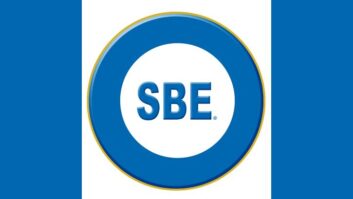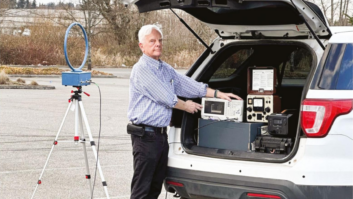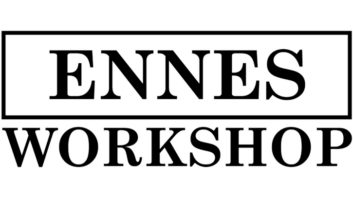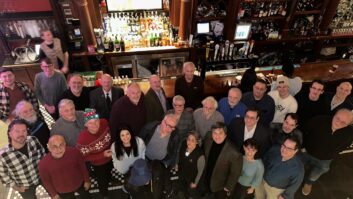Society Develops Broadcast Engineering College Curriculum, Groundwork for RF Hazard Training
WASHINGTON On solid financial footing and maintaining steady growth, the Society of Broadcast Engineers is in position to move ahead with critical issues facing the national organization, including RF hazard training and industry frequency coordination standards, according to its elected leader.
SBE President Ray Benedict’s second and final year as leader of the national group will focus on those issues along with the education demands facing broadcast engineers. SBE now has nearly 6,000 members.
Benedict, director of spectrum management for Viacom in Washington, says education continues to be at the top of his agenda for SBE. The organization formed an education committee in 2004 to examine how to address training for broadcast engineers working in an ever-changing industry.
The committee is addressing education needs of members and others involved in the technical operations of broadcast facilities, Benedict said.
“We want to help broadcast engineers cope with the significant changes they are facing, including IBOC, digital TV, RF hazard standards and everything else coming along in their universe. We have two areas of interest there: Education for new engineers and continuing education for existing engineers – and ways to standardize those things.”
Benedict said SBE plans to detail at NAB2005 its “multi-pronged approach” to how chapters train members, including the development of a program to work with colleges and universities that offer broadcast engineering classes (RW, Oct. 6, 2004, page 22).
Higher-ed certification
“We have developed a suggested curriculum for use by post-secondary schools that offer a broadcast engineering program or wish to develop one. The curriculum will provide a baseline education to students,” Benedict said.
SBE will introduce exams in several certification specialties beginning in April 2005. The first specialty will test on maintaining AM directional antennas. “We chose AM directional antennas first because it’s an established technology with established experts to draw on. We feel there has been a long-standing educational deficit in this area.
“We think (certification specialties) will be an important designation. Broadcast engineers will be able to add these specialty certifications to their primary certifications. The specialty designations will make engineers more attractive from a competitive standpoint,” Benedict said.
On the horizon is at least one other major issue “that could affect every single broadcast engineer” working today, Benedict said. The FCC is expected to release a Report and Order this year that will require some formal RF hazard and exposure training for all broadcast engineers and for anyone who goes into a controlled area.
RF hazard training
“This could be something of a bombshell. It’s been flying under the radar for several years now, ever since the FCC sought comment (in a Notice of Proposed Rulemaking) on radio frequency exposure. They have stepped up enforcement in a number of areas as a result. We are already working with suppliers that are doing that kind of training. We will enact formal training that will be acceptable to the FCC,” Benedict said.
Benedict says he expects the commission’s action to amend the RF rules to be released sometime in 2005. He said, “It’s really a groundbreaking kind of thing, affecting not only broadcast engineers but HVAC and the telephone industry as well.”
The RF exposure training issue is a good example of what Benedict perceives to be the SBE’s role in the lives of its membership.
“(SBE) looks ahead and determines possible issues that will impact our membership and then we devise a solution, whether it is through training or the regulatory route, to the problem.”
Another area of need is the frequency coordination of point-to-point microwave links, Benedict says. A subcommittee on BAS (Broadcast Auxiliary Service) Frequency Coordination Standards committee was formed in 2004 and is working to develop new interference standards in the 900 MHz band.
The subcommittee is looking at dBu ratios and antenna standards to determine what new receivers and existing ones are capable of, Benedict said. All 950 MHz Aural BAS stations became subject to the FCC Section 101.103(d) rule requiring a formal frequency coordination study and exhibit as of November 2003.
“When people try to relocate their STL aural links or even establish news ones, they are coming up with lots of interference cases,” Benedict said. “I’ve seen cases where the software has come up with 20 to 30 different interference cases from existing links.”
The subcommittee could develop frequency coordination criteria in time for NAB2005, but Benedict believes it’s more likely the work would be completed in time for SBE’s national meeting in Dallas in October.
“We hope the FCC will accept this work as industry-accepted procedures and allow the new format,” he said.
In Las Vegas
SBE expects to introduce a second version of its frequency coordination software at the NAB show in Las Vegas in April, Benedict said. The software includes a new module to help regional frequency coordinators handle special short-term events such as sporting and major news events, “such as a plane crash when you have 300 media people there covering it,” he said.
NAB2005 is expected to mark the debut of a new radio “Chief Operator’s Handbook.” Also, “Master Control” will be the topic at the Ennes Workshop on Saturday, April 16 (see story in the NAB preview section of this issue). The Ennes Education Foundation Trust is the educational arm of the SBE.
Benedict has been part of the leadership at SBE for many years. He has served the society as vice president, secretary and board member.
“The role of president is to chair its board of directors, work with the SBE staff, including SBE Executive Director John Poray, set goals and procedures for the national staff and to help set the strategic direction of the society,” Benedict said.
The association is in a strong financial position, Benedict said, with nearly $1 million in equity from its investments. SBE’s 2005 income is anticipated to be near $885,000, with an expense budget of $843,000 for this year.
“We are showing financial growth year to year. We have done very well with our equity investments. That allows us to do more things for our membership.”
Balloting to fill board member positions will take place this summer and will be tabulated on Sept. 1. Those elected will be installed during SBE’s national meeting in Dallas.
Benedict began his broadcast career nearly 50 years ago in Montpelier, Vt., at the former WSKI(AM), where he began hosting a radio show “playin’ rock-n-roll” in the eighth grade. Benedict eventually took up broadcast engineering, and except for several years in the U.S. Army, has spent his career in broadcasting.
He and his staff oversee approximately 2,000 broadcast and communications licenses for Viacom and its subsidiaries, including main broadcast, BAS, earth station, weather radar, experimental and Part 90 communications licenses for Viacom’s non-broadcast entities such as Paramount Parks.






